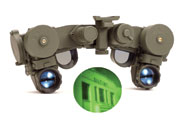Siltint has been coating ophthalmic lenses for more than 30 years, starting with tinting of glass lenses in 1972. During the 1970s and 1980s the company developed AR coatings initially for glass lenses and then plastics as the ophthalmic market began to evolve.
In the late 1980s Siltint created a precision optics business unit and in 2000 purchased a diamond-turning firm, allowing the company to produce customised precision lenses.
The company has become a key UK supplier for special products such as polycarbonate reflectors and diamond-turned plastic lenses. The knowledge gained from dealing in both ophthalmic and precision optical coatings has led to a key strength in dealing with plastic optics.
Siltint is now a fully approved supplier for coatings in the military market and is using these skills to create better products for the ophthalmic business.
Diamond-turned lenses
 Night-vision goggles for use by combat soldiers have in the past been cumbersome, with a large number of separate glass lenses making them fragile and less than ideal for regular use. Siltint’s diamond-turning division is able to shape the latest plastic lens materials such as high-index MR7 and high-quality acrylic to an accuracy of better than 0.2 microns.
Night-vision goggles for use by combat soldiers have in the past been cumbersome, with a large number of separate glass lenses making them fragile and less than ideal for regular use. Siltint’s diamond-turning division is able to shape the latest plastic lens materials such as high-index MR7 and high-quality acrylic to an accuracy of better than 0.2 microns.
The surface finish is close to one-millionth of a centimetre and therefore requires no polishing which can lead to inaccuracies in lens shape. This precision capability allows specially designed aspheric lenses to be produced to extremely high optical accuracy.
A specially designed aspheric lens can replace a number of traditional spherical lenses in an optical system, reducing their weight and size. In addition, the reduction in the number of optical surfaces  (interfaces), increases the transmission and reduces unwanted effects such as reflection, scatter and absorption. Siltint aspheric lenses allow the production of far smaller and lighter night-vision goggles.
(interfaces), increases the transmission and reduces unwanted effects such as reflection, scatter and absorption. Siltint aspheric lenses allow the production of far smaller and lighter night-vision goggles.
Antireflection coatings
The standard optical coatings used for military applications with glass lenses are applied at very high temperatures, typically over 300ºC. Such temperatures are required to ensure that the deposited thin films used to make up the optical coating are dense and exhibit a high level of durability and hardness.
High temperatures clearly cannot be used during coating of plastic aspheric lenses. Unfortunately, standard low temperature coatings used for applications such as ophthalmic AR coating don’t withstand the environmental requirements of this demanding market. Typical tests carried out, such as abrasion resistance to sand, chemical attack and salt spray, would normally remove or seriously damage any AR coating on plastic either immediately or within an unacceptable period of time.
Recently, Siltint launched a new ophthalmic coating process – Safire2 – which has been developed to provide an extremely durable, high efficiency AR coating to all plastics.
During development of Safire2, the philosophy was not to compromise quality for speed of production. Each step in production is optimised to reach maximum adhesion, long-term stability and a low level of reflections.
Optimum durability
The durability of the coating is carefully balanced to cope with the flexible plastic lens, while increasing the abrasion resistance to maximum possible level. The objective of the engineering team at Siltint was to produce a product which surpasses the quality of the best known mass brand names on the market.
Siltint is a UK independent coating supplier, so it was important for the process to work with a wide variety of lens materials, lens qualities and surface finishes.
Thin films are deposited using precision coating systems costing over £500,000. High energy plasma is utilised during deposition to produce dense structures without the need for heating.
This technique in conjunction with the choice of specific hard coat and per-fluorinated top coat chemistry provides a unique solution for coating of plastic lenses in precision optics.
Before Safire2 could be used for military applications, test samples had to pass through rigorous military (MIL) standard environmental testing procedures. In addition, regular quality control procedures are carried out to ensure consistency in production.
The approval of the Safire2 ophthalmic process for this type of application illustrates the improvements in coating technology which have been made and are expected by the ophthalmic market today.
Adam Brierley is commercial director for Siltint Industries
